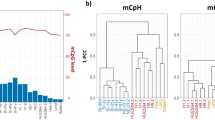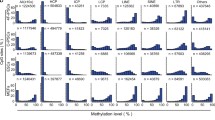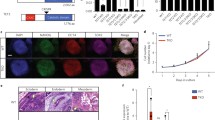Abstract
The effects of gene body DNA methylation on gene regulation still remains highly controversial. In this study, we generated whole genome bisulfite sequencing (WGBS) data with high sequencing depth in induced pluripotent stem cell (iPSC) and neuronal progentior cell (NPC), and investigated the relationship between DNA methylation changes in CpG islands (CGIs) and corresponding gene expression during NPC differentiation. Interestingly, differentially methylated CGIs were more abundant in intragenic regions compared to promoters and these methylated intragenic CGIs (iCGIs) were associated with neuronal development-related genes. When we compared gene expression level of methylated and unmethylated CGIs in intragenic regions, DNA methylation of iCGI was positively correlated with gene expression in contrast with promoter CGIs (pCGIs). To gain insight into regulatory mechanism mediated by iCGI DNA methylation, we executed motif searching in hypermethylated iCGIs and found NEUROD1 as a hypermethylated iCGI binding transcription factor. This study highlights give rise to possibility of activating role of hypermethylation in iCGIs and involvement of neuronal development related TFs.

The relationship between iCGI DNA methylation and expression of associated genes in neuronal developmental process. During iPSC to NPCdifferentiation, iCGI containing neural developmental genes show iCGI's DNA hypermethylation which is accompanied by gene activation and NEUROD1which is one of the core neuronal TFs interacts with hypermethylated iCGI regions.






Similar content being viewed by others
References
Ehrlich, M., & Lacey, M. (2013). DNA methylation and differentiation: Silencing, upregulation and modulation of gene expression. Epigenomics, 5(5), 553–568.
Dixon, J. R., Jung, I., Selvaraj, S., Shen, Y., Antosiewicz-Bourget, J. E., Lee, A. Y., Ye, Z., Kim, A., Rajagopal, N., Xie, W., Diao, Y., Liang, J., Zhao, H., Lobanenkov, V. V., Ecker, J. R., Thomson, J. A., & Ren, B. (2015). Chromatin architecture reorganization during stem cell differentiation. Nature, 518(7539), 331–336.
Nazor, K. L., Altun, G., Lynch, C., Tran, H., Harness, J. V., Slavin, I., Garitaonandia, I., Müller, F. J., Wang, Y. C., Boscolo, F. S., Fakunle, E., Dumevska, B., Lee, S., Park, H. S., Olee, T., D'Lima, D. D., Semechkin, R., Parast, M. M., Galat, V., Laslett, A. L., Schmidt, U., Keirstead, H. S., Loring, J. F., & Laurent, L. C. (2012). Recurrent variations in DNA methylation in human pluripotent stem cells and their differentiated derivatives. Cell Stem Cell, 10(5), 620–634.
Lister, R., Pelizzola, M., Dowen, R. H., Hawkins, R. D., Hon, G., Tonti-Filippini, J., Nery, J. R., Lee, L., Ye, Z., Ngo, Q. M., Edsall, L., Antosiewicz-Bourget, J., Stewart, R., Ruotti, V., Millar, A. H., Thomson, J. A., Ren, B., & Ecker, J. R. (2009). Human DNA methylomes at base resolution show widespread epigenomic differences. Nature, 462(7271), 315–322.
Barlow, D. P. (1995). Gametic imprinting in mammals. Science, 270(5242), 1610–1613.
Yen, P. H., Patel, P., Chinault, A. C., Mohandas, T., & Shapiro, L. J. (1984). Differential methylation of hypoxanthine phosphoribosyltransferase genes on active and inactive human X chromosomes. Proceedings of the National Academy of Sciences of the United States of America, 81(6), 1759–1763.
Deaton, A. M., & Bird, A. (2011). CpG islands and the regulation of transcription. Genes & Development, 25(10), 1010–1022.
Bird, A. (2002). DNA methylation patterns and epigenetic memory. Genes & Development, 16(1), 6–21.
Strichman-Almashanu, L. Z., Lee, R. S., Onyango, P. O., Perlman, E., Flam, F., Frieman, M. B., & Feinberg, A. P. (2002). A genome-wide screen for normally methylated human CpG islands that can identify novel imprinted genes. Genome Research, 12(4), 543–554.
Saxonov, S., Berg, P., & Brutlag, D. L. (2006). A genome-wide analysis of CpG dinucleotides in the human genome distinguishes two distinct classes of promoters. Proceedings of the National Academy of Sciences of the United States of America, 103(5), 1412–1417.
Moore, L. D., Le, T., & Fan, G. (2013). DNA methylation and its basic function. Neuropsychopharmacology, 38(1), 23–38.
Saksouk, N., Simboeck, E., & Dejardin, J. (2015). Constitutive heterochromatin formation and transcription in mammals. Epigenetics & Chromatin, 8, 3.
Medvedeva, Y. A., Fridman, M. V., Oparina, N. J., Malko, D. B., Ermakova, E. O., Kulakovskiy, I. V., Heinzel, A., & Makeev, V. J. (2010). Intergenic, gene terminal, and intragenic CpG islands in the human genome. BMC Genomics, 11, 48–48.
Li, E., & Zhang, Y. (2014). DNA methylation in mammals. Cold Spring Harbor Perspectives in Biology, 6(5), a019133.
Medvedeva, Y. A., Khamis, A. M., Kulakovskiy, I. V., Ba-Alawi, W., Bhuyan, M. S. I., Kawaji, H., Lassmann, T., Harbers, M., Forrest, A. R. R., Bajic, V. B., & The FANTOM consortium. (2014). Effects of cytosine methylation on transcription factor binding sites. BMC Genomics, 15, 119.
Jones, P. A., & Baylin, S. B. (2007). The epigenomics of cancer. Cell, 128(4), 683–692.
Plachot, C., & Lelievre, S. A. (2004). DNA methylation control of tissue polarity and cellular differentiation in the mammary epithelium. Experimental Cell Research, 298(1), 122–132.
Hackett, J. A., Reddington, J. P., Nestor, C. E., Dunican, D. S., Branco, M. R., Reichmann, J., Reik, W., Surani, M. A., Adams, I. R., & Meehan, R. R. (2012). Promoter DNA methylation couples genome-defence mechanisms to epigenetic reprogramming in the mouse germline. Development, 139(19), 3623–3632.
Gates, L. A., Foulds, C. E., & O'Malley, B. W. (2017). Histone Marks in the 'Driver's Seat': Functional roles in steering the transcription cycle. Trends in Biochemical Sciences, 42(12), 977–989.
Lee, S. M., Lee, J., Noh, K. M., Choi, W. Y., Jeon, S., Oh, G. T., Kim-Ha, J., Jin, Y., Cho, S. W., & Kim, Y. J. (2017). Intragenic CpG islands play important roles in bivalent chromatin assembly of developmental genes. Proceedings of the National Academy of Sciences of the United States of America, 114(10), E1885–E1894.
Takahashi, K., & Yamanaka, S. (2006). Induction of pluripotent stem cells from mouse embryonic and adult fibroblast cultures by defined factors. Cell, 126(4), 663–676.
Marchetto, M. C., Brennand, K. J., Boyer, L. F., & Gage, F. H. (2011). Induced pluripotent stem cells (iPSCs) and neurological disease modeling: Progress and promises. Human Molecular Genetics, 20(R2), R109–R115.
Liu, C., et al., (2018) Modeling human diseases with induced pluripotent stem cells: from 2D to 3D and beyond. Development, 145(5).
McCauley, H. A., & Wells, J. M. (2017). Pluripotent stem cell-derived organoids: Using principles of developmental biology to grow human tissues in a dish. Development, 144(6), 958–962.
Vaskova, E. A., Stekleneva, A. E., Medvedev, S. P., & Zakian, S. M. (2013). "epigenetic memory" phenomenon in induced pluripotent stem cells. Acta Naturae, 5(4), 15–21.
Ang, Y. S., Gaspar-Maia, A., Lemischka, I. R., & Bernstein, E. (2011). Stem cells and reprogramming: Breaking the epigenetic barrier? Trends in Pharmacological Sciences, 32(7), 394–401.
de Boni, L., et al., (2018) DNA methylation alterations in iPSC- and hESC-derived neurons: Potential implications for neurological disease modeling. Clinical Epigenetics. 10.
Roost, M. S., Slieker, R. C., Bialecka, M., van Iperen, L., Gomes Fernandes, M. M., He, N., Suchiman, H. E. D., Szuhai, K., Carlotti, F., de Koning, E. J. P., Mummery, C. L., Heijmans, B. T., & Chuva de Sousa Lopes, S. M. (2017). DNA methylation and transcriptional trajectories during human development and reprogramming of isogenic pluripotent stem cells. Nature Communications, 8, 908.
Kim, H. W., Yang, K., Jeong, W. J., Choi, S. J., Lee, J. S., Cho, A. N., Chang, G. E., Cheong, E., Cho, S. W., & Lim, Y. B. (2016). Photoactivation of noncovalently assembled peptide ligands on carbon nanotubes enables the dynamic regulation of stem cell differentiation. ACS Applied Materials & Interfaces, 8(40), 26470–26481.
Seo, H. I., Cho, A. N., Jang, J., Kim, D. W., Cho, S. W., & Chung, B. G. (2015). Thermo-responsive polymeric nanoparticles for enhancing neuronal differentiation of human induced pluripotent stem cells. Nanomedicine, 11(7), 1861–1869.
Shin, J., Choi, E. J., Cho, J. H., Cho, A. N., Jin, Y., Yang, K., Song, C., & Cho, S. W. (2017). Three-dimensional Electroconductive hyaluronic acid hydrogels incorporated with carbon nanotubes and Polypyrrole by catechol-mediated dispersion enhance neurogenesis of human neural stem cells. Biomacromolecules, 18(10), 3060–3072.
Li, L., Roh, J. H., Chang, E. H., Lee, Y., Lee, S., Kim, M., Koh, W., Chang, J. W., Kim, H. J., Nakanishi, M., Barker, R. A., Na, D. L., & Song, J. (2018). iPSC modeling of Presenilin1 mutation in Alzheimer's disease with cerebellar ataxia. Experimental Neurobiology, 27(5), 350–364.
Lee, S. M., Lee, Y. G., Bae, J. B., Choi, J. K., Tayama, C., Hata, K., Yun, Y., Seong, J. K., & Kim, Y. J. (2014). HBx induces hypomethylation of distal intragenic CpG islands required for active expression of developmental regulators. Proceedings of the National Academy of Sciences of the United States of America, 111(26), 9555–9560.
Bolstad, B. M., Irizarry, R. A., Astrand, M., & Speed, T. P. (2003). A comparison of normalization methods for high density oligonucleotide array data based on variance and bias. Bioinformatics, 19(2), 185–193.
Grant, C. E., Bailey, T. L., & Noble, W. S. (2011). FIMO: Scanning for occurrences of a given motif. Bioinformatics, 27(7), 1017–1018.
Juhling, F., et al. (2016). Metilene: Fast and sensitive calling of differentially methylated regions from bisulfite sequencing data. Genome Research, 26(2), 256–262.
Greenberg, M. V. C., & Bourc'his, D. (2019). The diverse roles of DNA methylation in mammalian development and disease. Nature Reviews. Molecular Cell Biology, 20(10), 590–607.
Chen, K.F., et al., (2015) Broad H3K4me3 is associated with increased transcription elongation and enhancer activity at tumor-suppressor genes. Nature Genetics. 47(10): p. 1149−+.
Heintzman, N. D., Stuart, R. K., Hon, G., Fu, Y., Ching, C. W., Hawkins, R. D., Barrera, L. O., van Calcar, S., Qu, C., Ching, K. A., Wang, W., Weng, Z., Green, R. D., Crawford, G. E., & Ren, B. (2007). Distinct and predictive chromatin signatures of transcriptional promoters and enhancers in the human genome. Nature Genetics, 39(3), 311–318.
Barski, A., Cuddapah, S., Cui, K., Roh, T. Y., Schones, D. E., Wang, Z., Wei, G., Chepelev, I., & Zhao, K. (2007). High-resolution profiling of histone methylations in the human genome. Cell, 129(4), 823–837.
Voigt, P., Tee, W. W., & Reinberg, D. (2013). A double take on bivalent promoters. Genes & Development, 27(12), 1318–1338.
Azuara, V., Perry, P., Sauer, S., Spivakov, M., Jørgensen, H. F., John, R. M., Gouti, M., Casanova, M., Warnes, G., Merkenschlager, M., & Fisher, A. G. (2006). Chromatin signatures of pluripotent cell lines. Nature Cell Biology, 8(5), 532–U189.
Hou, P. S., Chuang, C. Y., Kao, C. F., Chou, S. J., Stone, L., Ho, H. N., Chien, C. L., & Kuo, H. C. (2013). LHX2 regulates the neural differentiation of human embryonic stem cells via transcriptional modulation of PAX6 and CER1. Nucleic Acids Research, 41(16), 7753–7770.
Bel-Vialar, S., Medevielle, F., & Pituello, F. (2007). The on/off of Pax6 controls the tempo of neuronal differentiation in the developing spinal cord. Developmental Biology, 305(2), 659–673.
Muranishi, Y., Terada, K., & Furukawa, T. (2012). An essential role for Rax in retina and neuroendocrine system development. Development, Growth & Differentiation, 54(3), 341–348.
Mattes, B., Weber, S., Peres, J., Chen, Q., Davidson, G., Houart, C., & Scholpp, S. (2012). Wnt3 and Wnt3a are required for induction of the mid-diencephalic organizer in the caudal forebrain. Neural Development, 7, 12.
Iwafuchi-Doi, M., & Zaret, K. S. (2014). Pioneer transcription factors in cell reprogramming. Genes & Development, 28(24), 2679–2692.
Rhee, I., Bachman, K. E., Park, B. H., Jair, K. W., Yen, R. W. C., Schuebel, K. E., Cui, H., Feinberg, A. P., Lengauer, C., Kinzler, K. W., Baylin, S. B., & Vogelstein, B. (2002). DNMT1 and DNMT3b cooperate to silence genes in human cancer cells. Nature, 416(6880), 552–556.
Messerschmidt, D. M., Knowles, B. B., & Solter, D. (2014). DNA methylation dynamics during epigenetic reprogramming in the germline and preimplantation embryos. Genes & Development, 28(8), 812–828.
Smith, Z. D., & Meissner, A. (2013). DNA methylation: Roles in mammalian development. Nature Reviews. Genetics, 14(3), 204–220.
Jeziorska, D. M., Murray, R. J. S., de Gobbi, M., Gaentzsch, R., Garrick, D., Ayyub, H., Chen, T., Li, E., Telenius, J., Lynch, M., Graham, B., Smith, A. J. H., Lund, J. N., Hughes, J. R., Higgs, D. R., & Tufarelli, C. (2017). DNA methylation of intragenic CpG islands depends on their transcriptional activity during differentiation and disease. Proceedings of the National Academy of Sciences of the United States of America, 114(36), E7526–E7535.
Xu, W., Li, J., Rong, B., Zhao, B., Wang, M., Dai, R., Chen, Q., Liu, H., Gu, Z., Liu, S., Guo, R., Shen, H., Wu, F., & Lan, F. (2020). DNMT3A reads and connects histone H3K36me2 to DNA methylation. Protein & Cell, 11(2), 150–154.
Frati, G., Luciani, M., Meneghini, V., de Cicco, S., Ståhlman, M., Blomqvist, M., Grossi, S., Filocamo, M., Morena, F., Menegon, A., Martino, S., & Gritti, A. (2018). Human iPSC-based models highlight defective glial and neuronal differentiation from neural progenitor cells in metachromatic leukodystrophy. Cell Death & Disease, 9, 698.
D'Aiuto, L., et al. (2015). Large-scale generation of human iPSC-derived neural stem cells/early neural progenitor cells and their neuronal differentiation (vol 10, pg 365, 2014). Organogenesis, 11(2), 93–93.
Simao, D., et al. (2018). Recapitulation of human neural microenvironment signatures in iPSC-derived NPC 3D differentiation. Stem Cell Reports, 11(2), 552–564.
Skeath, J. B., & Carroll, S. B. (1994). The Achaete-Scute complex - generation of cellular-pattern and fate within the Drosophila nervous-system. FASEB Journal, 8(10), 714–721.
Wapinski, O. L., Vierbuchen, T., Qu, K., Lee, Q. Y., Chanda, S., Fuentes, D. R., Giresi, P. G., Ng, Y. H., Marro, S., Neff, N. F., Drechsel, D., Martynoga, B., Castro, D. S., Webb, A. E., Südhof, T. C., Brunet, A., Guillemot, F., Chang, H. Y., & Wernig, M. (2013). Hierarchical mechanisms for direct reprogramming of fibroblasts to neurons. Cell, 155(3), 621–635.
Hahn, M.A., et al., (2019) Reprogramming of DNA methylation at NEUROD2-bound sequences during cortical neuron differentiation. Science Advances. 5(10).
Kulis, M., Queirós, A. C., Beekman, R., & Martín-Subero, J. I. (2013). Intragenic DNA methylation in transcriptional regulation, normal differentiation and cancer. Biochimica et Biophysica Acta, 1829(11), 1161–1174.
Zhu, H., Wang, G. H., & Qian, J. (2016). Transcription factors as readers and effectors of DNA methylation. Nature Reviews Genetics, 17(9), 551–565.
Acknowledgments
This work was supported by Samsung Science and Technology Foundation Project SSTF-BA1601-13.
Accession Codes
All Whole Genome Bisulfite sequencing (WGBS), mRNA-seq and ChIP-seq data for iPSC and NPC have been submitted to the Gene Expression Omnibus (GEO) under accession GSE156723.
Author information
Authors and Affiliations
Contributions
W.-Y.C. and Y.-J.K. conceived and designed the study. W.-Y.C., A.J.L and J.L. produced and processed next generation sequencing data and W.-Y.C. analyzed the data. A.-N.C. performed cellular work for iPSC maintaining and differentiation. I.-K.J. and S.-W.C. contributed advice in experiment and data analysis. W.-Y.C, J.-H.H. and L.K.K wrote the manuscript. L.K.K and Y.-J.K. supervised the project.
Corresponding authors
Ethics declarations
Conflict of interest
The authors declare no conflict of interest.
Additional information
Publisher’s Note
Springer Nature remains neutral with regard to jurisdictional claims in published maps and institutional affiliations.
Electronic supplementary material
Supplementary Fig. 1.
Characterization of function of genes according to localization of CGIs. (A-D) Gene Ontology analysis of genes containing hypermethylated promoter CGIs (pCGIs), hypomethylated pCGIs, hypermethylated intragenic CGIs (iCGIs) and hypomethylated iCGIs. The p-values were calculated using the Benjamini–Hochberg method in DAVID. Supplementary Table 1. The list of unmethylated iCGIs which were activated by neural differentiation (PDF 85 kb) (PDF 85 kb)
Rights and permissions
About this article
Cite this article
Choi, WY., Hwang, JH., Cho, AN. et al. DNA Methylation of Intragenic CpG Islands are Required for Differentiation from iPSC to NPC. Stem Cell Rev and Rep 16, 1316–1327 (2020). https://doi.org/10.1007/s12015-020-10041-6
Accepted:
Published:
Issue Date:
DOI: https://doi.org/10.1007/s12015-020-10041-6




